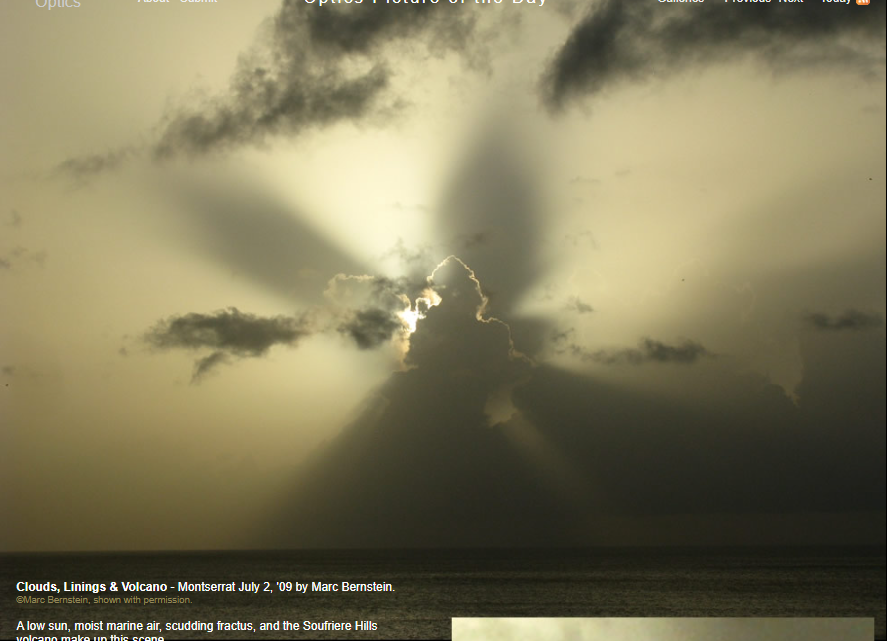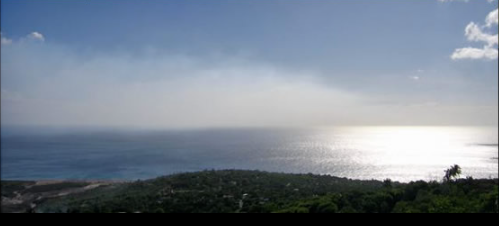Clouds, linings & volcano
Clouds, Linings & Volcano: A Captivating Atmospheric Phenomenon
The interplay between clouds, linings, and a volcano can create a captivating scene in the sky. This unique atmospheric optics phenomenon occurs when a low sun, moist marine air, scudding fractus clouds, and the presence of a volcano converge to create a mesmerizing display. In this article, we will delve into the intricacies of this phenomenon and explore the factors that contribute to its formation.
The Intriguing Shadows
One of the most striking features of this phenomenon is the presence of long cloud shadows that are cast through the moisture-laden marine air layer. These shadows possess a three-dimensional quality, appearing as volumes of darkness rather than two-dimensional shadows cast on a thin haze layer. While these shadows may appear to diverge radially from the sun's position, they are actually parallel due to perspective.
The Silver Lining
Cumulus clouds, known for their puffy appearance, play a significant role in this atmospheric phenomenon. These clouds have a high concentration of water droplets, causing light rays to scatter multiple times and become attenuated. As a result, cumulus clouds appear dark when viewed against the sun, except for their edges. The edges of these clouds exhibit a bright "silver lining" effect. This occurs because there are fewer water droplets along the line of sight at the edges, causing rays to scatter once or only a few times predominantly in the forward direction.
Sharp Edges vs. Fuzzy Clouds
A question that often arises when observing this phenomenon is why some clouds have sharp edges while others appear fuzzy. The answer lies in the varying concentration of water droplets within the cloud. Clouds with sharp edges have a higher concentration of droplets, resulting in a more defined boundary. On the other hand, fuzzy clouds have a lower concentration of droplets, leading to a less distinct edge.
The Influence of a Volcano
The presence of a volcano, such as the Soufriere Hills volcano in Montserrat, adds an additional element to this atmospheric display. The plume emitted by the volcano consists mainly of water vapor (H2O) and sulfur dioxide (SO2), with variable amounts of fine ash depending on the trade wind speed. During the day, the plume becomes visible downwind of the volcano, mixed with condensation from fumaroles and orographic clouds. This mixture gives the plume a slight bluish cast.
Factors Affecting Plume Visibility
The visibility of the volcanic plume is influenced by several factors. The prevailing easterly trade winds typically drive the plume westwards. However, when the wind direction shifts to southerly, the smell of sulfur dioxide can become quite strong at observatories located in the vicinity. In the late afternoon, the lower angle of the sun enhances the visibility of the plume as it extends westwards over the Caribbean.
The Anatomy of a Volcanic Plume
Understanding the structure of a volcanic plume is essential to grasp its behavior during this atmospheric phenomenon. The plume originates from numerous fumaroles on the volcanic dome and possibly from more diffuse degassing. The upper part of the plume rises to an altitude of approximately 1500-2000 meters, while the lower part drifts down to around 500 meters. The volcanic dome itself stands at an elevation of approximately 1050 meters and lacks a crater.
In conclusion, the interaction between clouds, linings, and a volcano creates a captivating atmospheric optics spectacle. The interplay of light, moisture, and volcanic emissions gives rise to long shadows, silver linings, and distinct cloud edges. Understanding these phenomena adds depth to our appreciation of the natural world and reminds us of the incredible complexity and beauty that can be found in the sky above.

Clouds, Linings & Volcano - Montserrat July 2, '09 by Marc Bernstein. ©Marc Bernstein, shown with permission.
A low sun, moist marine air, scudding fractus, and the Soufriere Hills volcano make up this scene.
Long cloud shadows are cast through the moisture laden marine air layer. They are likely 3D shadows, volumes of darkness rather than 2D shadows cast on a thin haze layer. They are all parallel but perspective makes them appear to diverge radially from the sun's position.
The cloud has a 'silver lining'. Cumulus clouds have a high concentration of water droplets and light rays are scattered many times and attenuated - the cloud is 'optically thick' and appears dark when against the sun. All except the edges that is where there are fewer droplets along the line of sight. At the edges a ray is scattered once or only a few times and predominantly in the forward direction to give the bright 'silver lining'. But why are some clouds sharp edged and others fuzzy?
From the left (see the clear day view) there is a plume from the Soufriere volcano. Marc adds ".. the plume is mostly H2O and SO2 with variable amounts of fine ash mixed in depending upon trade wind speed. During the day it is mostly visible immediately downwind of the volcano mixed in with condensation from fumaroles and orographic clouds giving it a slight bluish cast. I don't know what the SO2 flux was yesterday evening (time of image) but typical outputs range from 500 to 1000 tons per day. Most of the time the plume is driven westwards by the prevailing easterly trades. Occasionally when the wind turns to southerly the SO2 smell can be quite strong at the observatory. In the late afternoon the lower sun angle helps make the plume visible westwards out over the Caribbean. The summit of the volcanic dome is around 1050 m but there is no crater. The plume originates mostly from numerous fumaroles on the dome and probably also from more diffuse degassing. The upper part of the plume probably rises to 1500-2000 m and the lower part drifts down maybe to 500 m."


Note: this article has been automatically converted from the old site and may not appear as intended. You can find the original article here.
Reference Atmospheric Optics
If you use any of the definitions, information, or data presented on Atmospheric Optics, please copy the link or reference below to properly credit us as the reference source. Thank you!
-
<a href="https://atoptics.co.uk/blog/clouds-linings-volcano/">Clouds, linings & volcano</a>
-
"Clouds, linings & volcano". Atmospheric Optics. Accessed on November 26, 2024. https://atoptics.co.uk/blog/clouds-linings-volcano/.
-
"Clouds, linings & volcano". Atmospheric Optics, https://atoptics.co.uk/blog/clouds-linings-volcano/. Accessed 26 November, 2024
-
Clouds, linings & volcano. Atmospheric Optics. Retrieved from https://atoptics.co.uk/blog/clouds-linings-volcano/.